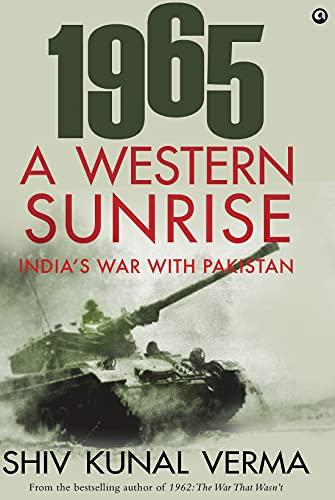1965 A WESTERN SUNRISE INDIA'S WAR WITH PAKISTAN

In 1965, while India was still licking its wounds from the disastrous war against the Chinese in 1962, the belligerent Pakistanis decided to wrest Kashmir from India. To test the waters, they launched their first military probes into the Rann of Kutch between February and May; India responded. By the end of July, India gave in to the dictates of the UN and stood down the troops it had mobilized in the Punjab and Kargil sectors in response to the Rann of Kutch skirmishes. Pakistan then launched its masterstroke—Operation Gibraltar—in Kashmir in August. Nearly 12,000 trained mujahids were covertly deployed in multiple groups, each named after historical plunderers of the subcontinent. Confident that they had superior armour (M-47 and M-48 Patton tanks), better fighter planes (F-86 Sabres and F-104 Starfighters), and better submarines (Daphnes) than India, the Pakistanis expected that in the event of an expanded war, the Indians would collapse just as they had against China in NEFA three years previously. However, India repulsed the attack and cut off the entry and exit points into the Kashmir Valley by capturing the Haji Pir Bulge. Operation Gibraltar fizzled out. Pakistan then launched Operation Grand Slam in September 1965 in Chhamb and Jaurian. The resultant Indian counter-attack saw the focus shift to various other sectors—Lahore, Barki, Kasur (Khem Karan), Fazilka, Sialkot, and Barmer—on the international border. With the two air forces getting involved almost immediately, the armed skirmishes turned into full-scale war. As they had in 1962, the junior officers and men of the Indian armed forces acquitted themselves admirably despite the on-the-fly reorganization of forces, lack of intelligence, obsolete equipment, and lacklustre military leadership. What could have ended in victory instead culminated in a stalemate. Official Indian figures put the total number of casualties at 12,714, out of which 2,763 were killed, 8,444 wounded, and 1,507 went missing.
After his earlier best-selling book on the 1962 conflict with China, the author seamlessly shifts gears and takes us to the 1965 War with Pakistan. From the Raan of Kutch to Kashmir, then to the plains of the Punjab it’s a breathtaking narrative of a war that was fought both on the ground and in the air.
Lieutenant General Ajay Singh Former Governor of Assam
By far the most lucid and detailed account of the 1965 War, the book sets the bar in military writing. Knitting together the political, the military and the personal, the quagmire of events suddenly become crystal clear.
Air Marshal Denzil Keelor Sabre Slayer